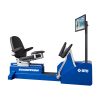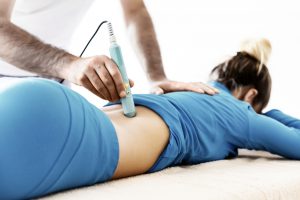
Kinesiology Tape: Smoke and Mirrors or the Perfect Rehab Tool?
Treatment GuidelinesKinesiology tape is touted as one of the best adjunct treatments. Let’s scrutinize the proposed benefits and see if taping really is an evidence-based practice.
Often, rehab treatments will explode in popularity due to the Olympics. After all, if a treatment is good enough for the highest-level athletes on earth, it must be good enough for the rest of us, right?
For instance, when Michael Phelps showed up to dominate the competition during one of his many Olympic appearances, viewers were not only blown away by his performance, but also by the strange red circles all over his shoulders. Because of Phelps, many Olympic fans had their first introduction to cupping therapy. This also spawned certifications and courses designed to teach cupping to clinicians, as patients began to demand the treatment for themselves.
A strikingly similar phenomenon occurred after an Olympic sprinter pointed to dry needling as one of the most effective tools that helped him compete.
Furthermore, kinesiology tape first gained wide exposure as beach volleyball players displayed these colorful straps across their bodies during matches.
Perhaps in a future article, we’ll tackle cupping therapy and dry needling to see if they really deliver what they promise. But for now, let’s take a look at kinesiology tape. Is this a treatment option that you need to add to your repertoire? Or is it yet another fad that looks cool, but provides very little benefit?
Kinesiology Tape in Brief
For the uninitiated, kinesiology tape is a stretchy yet supportive adhesive. It can be purchased online, at a pharmacy, or even from big box stores such as Walmart.
While it has become massively popular in the past decade or so, kinesiology tape has been around for nearly 50 years. By following different kinesiology taping methodologies, clinicians claim that they can inhibit or activate certain muscle groups. Further, kinesiology tape has been promoted as an incredible rehab tool that can help patients recover from a wide variety of ailments.
The Many Purported Benefits of Kinesiology Tape
Kinesiology tape has been touted as one of the best adjunct treatments for active individuals and athletes. In fact, many clinicians claim that the tape can provide benefits such as:
- Faster recovery after injury
- Improved posture
- Increased blood flow/decreased bruising
- And many more
Let’s tackle each one of these proposed benefits and see if they hold up under scientific scrutiny.
Recovery After Injury and Surgery
Anecdotally, many athletes and rehab patients will report that kinesiology tape has helped them recover more quickly than they would have without the treatment. But in the course of their rehab, we need to determine whether the tape truly played a major role in their recovery, or whether their symptoms resolved due to variables such as prescribed exercise, rest, other treatments, or a combination therein.
What Does the Evidence Say?
According to some research, kinesiology tape (in conjunction with other modalities) is more effective in reducing disability and aiding recovery than exercise or other rehab methods alone.
Specifically, one randomized clinical trial looked at the effect of kinesiology tape combined with exercise for mastectomy recovery. When compared to exercise alone, adding kinesiology tape seemed to improve multiple outcomes.1
Further, a study from 2021 found that kinesiology tape may improve muscle strength recovery after HIIT workouts.2 While a HIIT workout is certainly not analogous to a serious injury or surgery, these high intensity exercise sessions do impose some high levels of stress on the body.
Improved Posture
The posture of the average American is less than ideal. Due to our largely sedentary lifestyles, we often see people displaying forward head posture (FHP) and other detrimental postural abnormalities. Poor posture often leads to biomechanically inefficient movement. This inefficient movement, in turn, tends to lead to injury over time.
If a relatively inexpensive and low-risk tool such as kinesiology tape can improve the posture of our patients, we should be yelling it from the rooftops!
What Does the Evidence Say?
One of the major claimed benefits of kinesiology tape is that it helps to “cue” better posture. Recently, some studies seem to show that this is in fact true.
By specifically applying kinesiology tape with the goal of improving posture, both athletes and sedentary individuals can enjoy improved joint alignment and better body mechanics in their sports and daily lives.3, 4, 5
Decreased Ecchymosis and Improved Blood Flow
After an injury or surgery, many patients will have problems such as excessive bruising, swelling, and even lymphedema. Interestingly, there have been some reports of kinesiology tape reducing said symptoms. When these issues are minimized, recovery is often expedited.
To learn more about reducing post-injury swelling, see this recent article: Is the RICE Method Actually Helpful for Acute Injuries?
What Does the Evidence Say?
As far as reducing ecchymosis, kinesiology tape seems to be an effective choice. Along with many anecdotal reports, there have also been some published papers touting the beneficial effect that the tape can have on bruised areas.6
Multiple studies have examined blood flow changes associated with kinesiology tape. However, at this time, there have been mixed findings in this area. There appears to be no current consensus about the effect of kinesiology tape on blood flow specifically.7, 8
Which Clinicians Can Use Kinesiology Tape?
Depending on where you are located, you may see kinesiology tape being used by Athletic Trainers, Chiropractors, Occupational Therapists, Physical Therapists, and even personal trainers.
With any treatment that rapidly explodes in popularity, state boards generally have a “catch-up” period. They need to decide who can legally perform which treatments. Therefore, you should always be cautious before offering a new treatment for your patients.

Scope of Practice and Kinesiology Tape
As is always the case if you’re unsure about the legality of a treatment, consult with your individual clinic, the applicable state practice act, and any other relevant governing bodies.
No matter how effective a treatment is, you should never risk acting outside of your scope to provide it to your patients.
Types of Patients who Benefit from Kinesiology Tape
As we discussed earlier, kinesiology taping can provide many profound benefits when used as an adjunct therapy. Evidence supports this treatment to reduce ecchymosis, improve healing, and optimize posture. Therefore, this modality is appropriate for use with many different types of patients such as those recovering from surgery or injury, those with overuse conditions, and those with postural abnormalities.
Possible Risks Associated with Kinesiology Tape
Kinesiology tape is relatively risk-free. However, you should be certain that you check with your patients to confirm that they do not have any tape allergies or other issues that could lead to an adverse outcome.
Some patients will present with extremely sensitive skin. This may lead to redness and irritation. However, a true allergy to the tape would be rare. Most brands are latex-free and hypoallergenic. As long as the clinician isn’t using excessive tension when applying the tape, most patients will be able to tolerate the treatment.
Summary
Kinesiology tape, like many other long-standing treatments, has become very popular after being prominently displayed during the Olympics. However, the treatment is not only beneficial for high-level competitors, it also provides improved outcomes in a variety of other types of patients.
If you’ve heard of other clinicians in your area who are using kinesiology tape with great success, you may consider investigating this unique rehab tool yourself. It might just be the missing link for your patients who aren’t meeting their goals with traditional treatment modalities alone.
Bennett Richardson, PT, DPT, CSCS
Bennett Richardson, PT, DPT, CSCS is a physical therapist and writer. He is the owner of Richardson PT LLC, a mobile, cash-based physical therapy service out of Pittsburgh, PA. Ben is passionate about many health-related topics including weight loss and athletic performance. To get in touch with Ben, visit www.richardsonpt.com
References
- Tantawy SA, Kamel DM. The effect of kinesio taping with exercise compared with exercise alone on pain, range of motion, and disability of the shoulder in postmastectomy females: a randomized control trial. J Phys Ther Sci. 2016 Dec;28(12):3300-3305. doi: 10.1589/jpts.28.3300. Epub 2016 Dec 27. PMID: 28174439; PMCID: PMC5276748.
- Hung, B. L., Sun, C. Y., Chang, N. J., & Chang, W. D. (2021). Effects of Different Kinesio-Taping Applications for Delayed Onset Muscle Soreness after High-Intensity Interval Training Exercise: A Randomized Controlled Trial. Evidence-based complementary and alternative medicine : eCAM, 2021, 6676967. https://doi.org/10.1155/2021/6676967
- Yun, H. G., Lee, J. H., & Choi, I. R. (2020). Effects of Kinesiology Taping on Shoulder Posture and Peak Torque in Junior Baseball Players with Rounded Shoulder Posture: A Pilot Study. Life (Basel, Switzerland), 10(8), 139. https://doi.org/10.3390/life10080139
- Borzì, F., Szychlinska, M. A., Di Rosa, M., & Musumeci, G. (2018). A Short Overview of the Effects of Kinesio Taping for Postural Spine Curvature Disorders. Journal of functional morphology and kinesiology, 3(4), 59. https://doi.org/10.3390/jfmk3040059
- Sheikhi, B., Letafatkar, A., Hogg, J. et al. The influence of kinesio taping on trunk and lower extremity motions during different landing tasks: implications for anterior cruciate ligament injury. J EXP ORTOP 8, 25 (2021). https://doi.org/10.1186/s40634-021-00339-w
- Hopper, David. “Successful use of Kinesio tape to treat an acute muscle haematoma” The Journal of Haemophilia Practice, vol.2, no.1, 2015, pp.12-15. https://doi.org/10.17225/jhp.00042
- Liu K, Duan Z, Chen L, Wen Z, Zhu S, Qu Q, Chen W, Zhang S and Yu B (2020) Short-Term Effect of Different Taping Methods on Local Skin Temperature in Healthy Adults. Front. Physiol. 11:488. doi: 10.3389/fphys.2020.00488
- Banerjee, G., Briggs, M., & Johnson, M. I. (2020). The immediate effects of kinesiology taping on cutaneous blood flow in healthy humans under resting conditions: A randomised controlled repeated-measures laboratory study. PloS one, 15(2), e0229386. https://doi.org/10.1371/journal.pone.0229386





